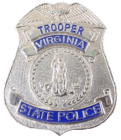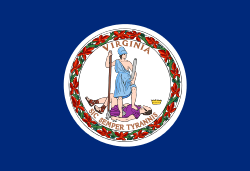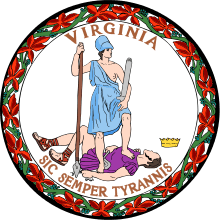Virginia State Police
| Virginia Department of State Police | |
|---|---|
| Common name | Virginia State Police |
| Abbreviation | VSP |
|
Patch of the Virginia Department of State Police | |
|
Badge of a Virginia State Trooper | |
|
Flag of the Commonwealth of Virginia | |
| Agency overview | |
| Formed | 1932 |
| Preceding agency | Virginia Division of Motor Vehicles |
| Employees | 2,697 (as of 2014) [1] |
| Legal personality | Governmental: Government agency |
| Jurisdictional structure | |
| Operations jurisdiction* | Commonwealth of Virginia, U.S. |
 | |
| Virginia State Police Divisions Map | |
| Size | 42,774 square miles (110,780 km2) |
| Population | 8,001,024 (2010 census) |
| General nature | |
| Operational structure | |
| Headquarters | Chesterfield, Virginia |
| Troopers & Special Agents | 1,974 (as of 2014) [1] |
| Civilians | 723 (as of 2014) [1] |
| Agency executives |
|
| Parent agency | Virginia Secretary of Public Safety |
| Divisions | 7 |
| Facilities | |
| Airplanes | 4 |
| Helicopters | 7 |
| Website | |
| http://www.vsp.state.va.us/ | |
| Footnotes | |
| * Divisional agency: Division of the country, over which the agency has usual operational jurisdiction. | |
The Virginia State Police, officially the Virginia Department of State Police, is a U.S. state law enforcement agency, conceived in 1919 and established in 1932, that acts as the state police force for the Commonwealth of Virginia in the United States. The agency originated out of the Virginia Department of Motor Vehicles as an inspector and enforcer of highway laws. It is currently one of fourteen agencies within the Cabinet Secretariat of Public Safety, under the leadership of Secretary Brian Moran.
History
In 1919 the Virginia State Police was conceived with the passing of the Automobile acts which state that the Commissioner of Motor Vehicles and his assistants were vested with the powers of a Sheriff for the purpose of enforcing the provisions of the law. The Secretary of the Commonwealth continued to be responsible for this regulation. The burden of enforcement remained with Sheriffs and Constables in counties and police officers in the cities and towns.
In 1919 the Motor Vehicle Act was passed, creating the first title laws for Virginia motor vehicle owners.
In 1932 inspectors became empowered to enforce criminal codes, as well as motor vehicle codes. In doing so legislators created a state enforcement group with the power to arrest anywhere in Virginia. A mobile enforcement agency was now ready for duty wherever civil strife or emergency conditions might exist that would warrant police personnel to ensure peace and security. It was at this time that inspectors began to be known as "Troopers."
On November 3, 1938, an executive order from Majors Bishop and Nicholas officially adopted the title of "State Trooper." The purpose of this was to identify specific members of the Division of Motor Vehicles performing the role of inspector and motorcycle deputy.
On March 14, 1942, the General Assembly abolished the existing Division of Motor Vehicles and created two separate agencies: The Division of Motor Vehicles and the Department of State Police. The act called for a position of superintendent for the State Police and a commissioner for the Division of Motor Vehicles. Major C. W. Woodson Jr. was officially appointed as superintendent for the State Police.
Training
Training is divided into 4 phases; Phase 1: 2 1/2 weeks of training mainly focusing on firearms, defensive tactics and basic law. Phase 2: Probate phase, probates are assigned to an FTO (Field Training Officer) for a minimum of 4 weeks. During this phase probates are exposed to the daily activities and duties of a Virginia State Trooper. Phase 3: This training phase consists of 26 weeks. Phase 4: During this phase new troopers are assigned to an FTO for 6 to 8 weeks.
Starting in 2017 Phase 2 will no longer be a part of the training. It will be 29 weeks straight at the academy and then new troopers will be assigned to an FTO for 6 to 8 weeks.
Organizational structure
The Department of State Police is primarily divided into three bureaus: Bureau of Field Operations (BFO), Bureau of Criminal Investigation (BCI), and Bureau of Administrative and Support Services (BASS).
- Department of State Police (commanded by the Colonel)
- Bureaus (commanded by a Lieutenant Colonel)
- Divisions (commanded by a Captain)
- Areas (commanded by a First Sergeant)
Uniform and equipment
The standard Class A Trooper uniform consists of a light gray colored button-up shirt, with long sleeves in winter and short sleeves in summer. A black tie is worn with the long-sleeve shirt. Patches are sewn to each sleeve. Gray pants with a Dark Blue stripe down the sides are worn year round. Black Clarino shoes and Sam Browne belt, without cross strap, gun belt are worn with the uniform.
A black semi-gloss straw Campaign hat is worn year round. A modified winter fur cap can be worn in the colder months.
A dark blue dress blouse and standard black Clarino Sam Browne gun belt, without the cross strap, are worn for special occasions. Dark blue work jackets are utilized for colder months. Black Commando Sweaters, or "wooly pullys" with proper patches and rank can also be worn by Troopers in cold weather.
Sergeants and First Sergeants wear silver, out lined in blue, chevrons showing their rank on both sleeves. Lieutenants and above wear their rank insignia on the shirt collar.
- Issued Weapons
Troopers are issued the SIG Sauer P229 .357 SIG DAK pistol, the Remington Model 870 12-gauge shotgun, and a Colt M4 Carbine patrol rifle.
- Previous Issued Weapons
- SIG Sauer P229 DA/SA .357 SIG issued from 1997 to 2004
- SIG Sauer P228 DA/SA 9mm issued from 1993 to 1997.
- Smith & Wesson Model 1026 10mm DA/SA 5-inch barrel stainless semi-auto pistol issued from 1990 to 1993.
- Smith & Wesson Model 64 .38 caliber 4-inch barrel stainless steel revolver issued in the mid 1970s to 1990.
- Colt Officer's Model .38 caliber 4-inch barrel revolver was used from 1967 until the mid-1970s.
- Colt Official Police .38 caliber 6-inch barrel revolver was used up until 1967.
- Thompson submachine gun .45 caliber used from the 1930s until 1974.
- Issued Vehicles
The department has used many different makes and models since its inception.
- Patrol Cars
Prior to 1928, inspectors only used automobiles once they had seized a vehicle used to transport illegal whiskey and it had been released to the Division for enforcement purposes by the courts. Fords became the first issued patrol vehicles in 1928. In 1932 white Chevrolet roadsters and white motorcycles were purchased and became known as the "The Great White Fleet". Fords and Chevys were the main staple of the patrol force in the 1930s and early 1940s. In 1945 post-war acquisitions of police vehicles were rare and troopers made arrangements to purchase vehicles wherever they could. Buicks and Pontiacs supplemented the fleet until auto manufacturers resumed normal production.
In 1948 the Department adopted the distinctive blue and gray paint scheme for all vehicles. Later in 1952 reflective markings were adopted and used for all marked vehicles. Those same markings are still in use today.
During the 1940s, 50's, 60's, 70's, and 80's the Department purchased Fords, Chevy's, Chryslers, and Plymouths for use as patrol cars. Ford's and Chevy's were used mainly used in the 90's and 2000's. Dodge Chargers were introduced into the fleet in 2006.
Red emergency lights were in use until 1985 and then were replaced with blue emergency lights. Bar lights were phased onto vehicles in 1988 replacing the single "bubble gum" light. "TROOPER" decals were added to the front fenders of patrol cars in 1998. Also in 1998 the Department adopted Ford silver replacing the gray in the traditional paint scheme. Only the hood, ceiling and trunk were painted blue. This was due to budget constraints and that Ford stop using that particular gray paint. "Slicktop" Chevrolet Impalas were put into use beginning in 2001. Seven "slicktop" 2002 Chevrolet 9C1 Camaros were put into service in high traffic areas in 2002.
In 2006 the Department purchased 30+ Hemi V8 Dodge Chargers and for the first time since 1948 adopted new graphics for the marked and slicktop Chargers. Current budget restraints prohibit the new markings from being implemented onto the standard fleet.
In 2008 the Virginia State Police's Dodge Charger was Law and Order Magazine's Police Vehicle Design Winner for State and Federal Agencies.
In 2013 the Ford Police Interceptor Sedan was added to the fleet of Virginia State Police vehicles since the Ford Crown Vic model ceased production.

Rank structure
| Rank | Insignia | Description |
|---|---|---|
| Colonel[2] | |
|
| Lieutenant Colonel[2] | |
|
| Major[2] | |
|
| Captain[2] | |
|
| Lieutenant[2] | |
|
| First Sergeant[2] | |
|
| Sergeant[2] | |
|
| Master Trooper[2] | |
Career Progression, based on length of service, 25+ years[2] |
| Senior Trooper[2] | |
Career Progression, based on length of service, 9+ years[2] |
| Trooper II[2] | |
Career Progression, automatic after 1 year probationary period[2] |
| Trooper I[2] | |
Probationary Trooper, 1st year in the field[2] |
| Trainee[2] | |
Status while attending the academy[2] |
| Probate[2] | |
Status prior to attending the academy and training in the field[2] |
Bureau of Criminal Investigation (BCI)[2]
- Lieutenant Colonel[2]
- Major[2]
- Captain[2]
- Lieutenant[2]
- First Sergeant[2]
- Senior Special Agent, career progression[2]
- Special Agent[2]
Fallen officers
| Trooper / Inspector | Date of Death | Details |
|---|---|---|
| W. Neville Hatcher | |
Killed while attempting to arrest a murder suspect |
| Phillip C. Via | |
Killed due to motorcycle accident while providing an escort for President Calvin Coolidge |
| Curtis Lee Wood | |
Killed when he was struck by an intoxicated driver |
| Inspector Thomas Allen Belt | |
Killed in a motorcycle accident in Loudoun County |
| Charles Bazil Bullock | |
Succumbed to injuries received in a motorcycle accident |
| William Raymond Thompson | |
Killed while attempting to arrest three bank robbers |
| Charles William Puckett | |
Succumbed to pneumonia contracted while pursuing and arresting a murder suspect |
| Clarence Lemuel Maynard | |
Killed in an accident while responding to a call |
| Urshell Thomas Mayo | |
Succumbed to injuries sustained in an accident |
| William Stafford Tinsley | |
Killed in an automobile accident |
| William Hawthorne Andrews | |
Succumbed to injuries sustained in an automobile accident |
| Trooper Robert Elvin Caldwell | |
Killed in an automobile accident |
| Joseph Benjamin Thomas | |
Killed in an airplane accident |
| Robert Edward Porter | |
Killed in an airplane accident |
| Wallace Monroe Simpson | |
Shot and killed by an escaped mental patient |
| Robert Wright Smith | |
Killed when his patrol car was struck by a passenger train |
| Walter Sinton Parrish | |
Killed in an automobile accident |
| Robert Louis Loder Jr. | |
Killed in an automobile accident |
| Robert Fulton Giles | |
Shot and killed by a suspect during an arrest |
| Henry Murray Brooks Jr. | |
Struck and killed by an automobile while investigating an automobile accident |
| Charles Eugene (Gene) Morris | |
Shot and killed while assisting deputies make an arrest |
| Garland Matthew Miller | |
Killed in an automobile accident |
| Warren Yokely Harless | |
Shot and killed while assisting deputies with an arrest |
| Jackie Monroe Bussard | |
Killed in an automobile accident |
| Donald Edward Lovelace | |
Struck and killed by an automobile during a traffic stop |
| Rannie DeWitt Kennedy | |
Killed in an automobile accident during a vehicle pursuit |
| James Read Hughes | |
Struck and killed by an automobile during a traffic stop |
| Claude Everett Seymour | |
Killed in an automobile accident |
| Bernard Walter Wright | |
Killed in an automobile accident during a pursuit |
| Garland West Fisher Jr. | |
Shot and killed after being abducted during a traffic stop |
| Robert Tinsley Lohr | |
Struck and killed by a vehicle while assisting a motorist |
| Robin Lee Farmer | |
Killed in an automobile accident during a pursuit |
| Rodney Dean Grimes | |
Killed in an automobile accident |
| Johnny Rush Bowman | |
Stabbed to death when an unidentified male attacked him at his home |
| James Leroy Biggs | |
Shot and killed during a traffic stop |
| Leo Whitt | |
Shot and killed during a traffic stop |
| Ricky Marshall McCoy | |
Shot and killed during a traffic stop |
| Alexander McKie Cochran III | |
Shot and killed while responding to a domestic disturbance in his neighborhood |
| Harry Lee Henderson | |
Struck and killed by a truck during a traffic stop |
| Jacqueline Vernon | |
Struck and killed by a Metro Bus during a traffic stop |
| Jerry Lynn Hines | |
Shot and killed during a traffic stop |
| Jose M. Cavazos | |
Shot and killed during a traffic stop |
| Henry Noel Harmon | |
Shot and paralyzed on 1-10-60, & died 2-7-95, due to complications from the wound |
| Gregory Patton Fleenor | |
Killed in an automobile accident |
| Jessica Jean Cheney | |
Killed while directing traffic at the scene of an accident |
| Daniel Lee Williams | |
Died two days after being critically injured in a car accident |
| Charles Mark Cosslett | |
Killed in a motorcycle accident |
| Michael Todd Blanton | |
After stopping a DUI driver was dragged by vehicle & killed after it crashed |
| Kevin Carder Manion | |
Accidentally shot and killed by a rifle that discharged in a wrecked vehicle while being loaded |
| Robert A. Hill Sr. | |
Struck and killed by a vehicle during a traffic stop |
| Mark David Barrett | |
Drowned during Search and Recovery Team training dive exercise |
| Adam M Bowen | |
Killed in an automobile accident |
| Andrew David Fox | Struck and killed by vehicle while directing traffic at the Virginia State Fair | |
| Junius A. Walker | Shot and killed while checking a disabled vehicle on I-85 near mile marker 45 in Dinwiddie County | |
| Nathan-Michael W. Smith | Killed in an automobile accident | |
| Chad Dermyer | March 31, 2016 | Shot while in training, after approaching a man as a part of exercise |
See also
- List of law enforcement agencies in Virginia
- State police
- State patrol NO State Patrol
- Highway patrol NO Highway Patrol
- Virginia Capitol Police



